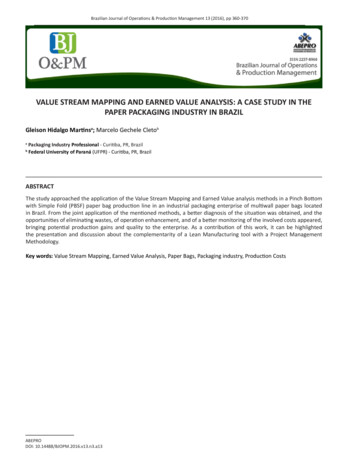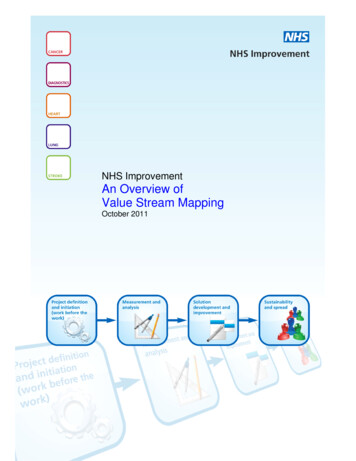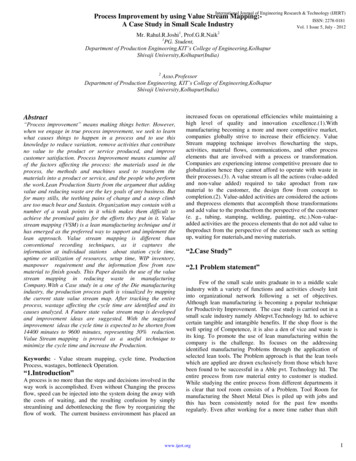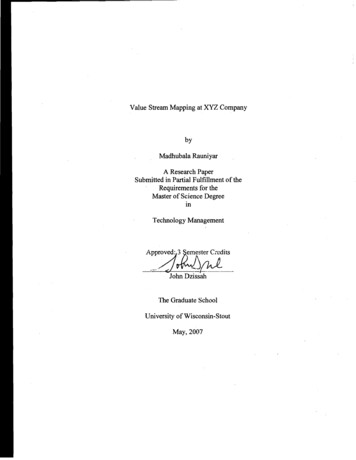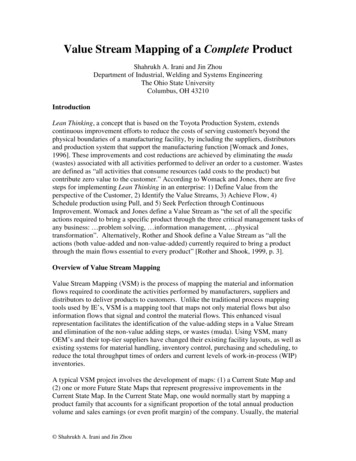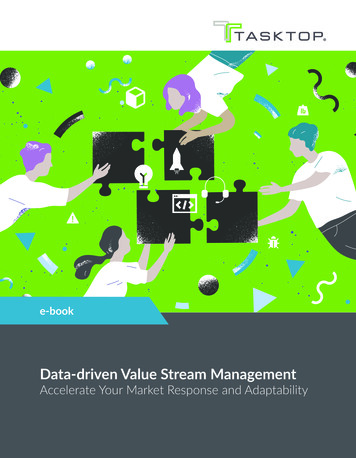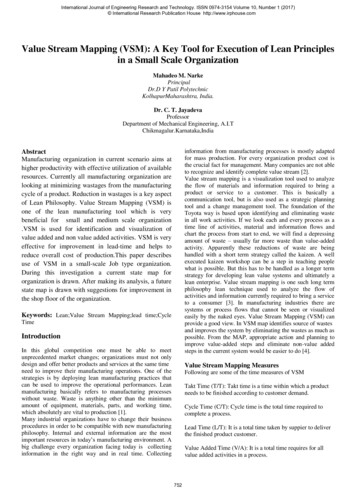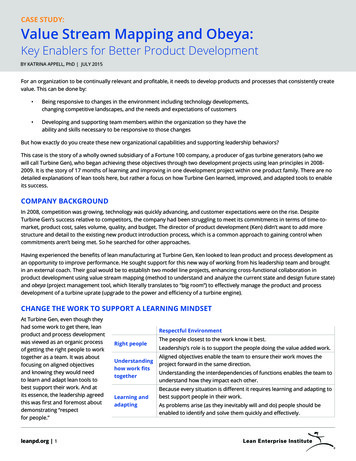
Transcription
Case study:Value Stream Mapping and Obeya:Key Enablers for Better Product Developmentby Katrina Appell, PhD July 2015For an organization to be continually relevant and profitable, it needs to develop products and processes that consistently createvalue. This can be done by: Being responsive to changes in the environment including technology developments,changing competitive landscapes, and the needs and expectations of customers Developing and supporting team members within the organization so they have theability and skills necessary to be responsive to those changesBut how exactly do you create these new organizational capabilities and supporting leadership behaviors?This case is the story of a wholly owned subsidiary of a Fortune 100 company, a producer of gas turbine generators (who wewill call Turbine Gen), who began achieving these objectives through two development projects using lean principles in 20082009. It is the story of 17 months of learning and improving in one development project within one product family. There are nodetailed explanations of lean tools here, but rather a focus on how Turbine Gen learned, improved, and adapted tools to enableits success.Company BackgroundIn 2008, competition was growing, technology was quickly advancing, and customer expectations were on the rise. DespiteTurbine Gen’s success relative to competitors, the company had been struggling to meet its commitments in terms of time-tomarket, product cost, sales volume, quality, and budget. The director of product development (Ken) didn’t want to add morestructure and detail to the existing new product introduction process, which is a common approach to gaining control whencommitments aren’t being met. So he searched for other approaches.Having experienced the benefits of lean manufacturing at Turbine Gen, Ken looked to lean product and process development asan opportunity to improve performance. He sought support for this new way of working from his leadership team and broughtin an external coach. Their goal would be to establish two model line projects, enhancing cross-functional collaboration inproduct development using value stream mapping (method to understand and analyze the current state and design future state)and obeya (project management tool, which literally translates to “big room”) to effectively manage the product and processdevelopment of a turbine uprate (upgrade to the power and efficiency of a turbine engine).Change the Work to Support a Learning MindsetAt Turbine Gen, even though theyhad some work to get there, leanproduct and process developmentwas viewed as an organic processof getting the right people to worktogether as a team. It was aboutfocusing on aligned objectivesand knowing they would needto learn and adapt lean tools tobest support their work. And atits essence, the leadership agreedthis was first and foremost aboutdemonstrating “respectfor people.”leanpd.org 1Respectful EnvironmentRight peopleUnderstandinghow work fitstogetherLearning andadaptingThe people closest to the work know it best.Leadership’s role is to support the people doing the value added work.Aligned objectives enable the team to ensure their work moves theproject forward in the same direction.Understanding the interdependencies of functions enables the team tounderstand how they impact each other.Because every situation is different it requires learning and adapting tobest support people in their work.As problems arise (as they inevitably will and do) people should beenabled to identify and solve them quickly and effectively.
Turbine Gen intentionally worked to establish an enabling bureaucracy by creatinga management structure aimed at supporting employees in their work. To start,Ken identified a skilled project manager (Greg) to assume a role resemblingToyota’s chief engineer. Greg had previous experience in engineering across variousfunctions and industries. He had experience working directly with customers anddownstream partners of the development process. Equally important, he had theinterpersonal skills and emotional intelligence to know when to challenge teammembers and when to back off.Greg became an avid student of lean product and process development,consciously working to develop himself as a coach. He acted as a “servant leader”enabling the team to effectively and efficiently collaborate, solve problems, andcomplete work. When organizational barriers arose, he was given the support heneeded from Ken, who worked to remove organizational and functional barriers tothis new way of working. This senior leadership support not only enabled the teamto be successful in how they interfaced with others outside of the core project team,but conveyed to team members that this new approach to work should be takenseriously. All team members would be accountable to supporting each other, whilealso being given the support needed to work in this new way.Enabling BureaucracyEnabling bureaucracies use rules,procedures and structure to supportthe work of employees. Whereascoercive bureaucracies use rules,procedures and structure to controlemployees to ensure that theydo the right thing (Adler 1999).An approach designed to helpemployees determine if the processis operating to standard, help themsolve problems that inevitably occur,and help them identify improvementopportunities will support anenabling bureaucracy (Adler ,andBorys 1996).The team primarily learned by doing while executing the turbine uprate project, developing their capabilities with coachingfrom Greg the project manager and the external coach. The core project team had representatives from the functional areasinvolved with the development of the turbine uprate, including engineering functions such as design, manufacturing, tooling,and packaging as well as non-engineering functions such as sales, marketing, and customer service. All team members pulledknowledge from each other, external resources, and other reference material. In this particular case, Turbine Gen intentionallyadapted components of The Lean Product Development System model, as described by James Morgan and Jeffrey Liker in TheToyota Product Development System: Integrating People, Process, and Technology, with the direct support of their coach:Lean Product and Process Model and 13 Principles5. D evelop a “Chief Engineer System” to Integrate11. A dapt Technology to Fit your People andDevelopment from start to finish.Process.6. O rganize to balance Functional Expertise and12. A lign your Organization through Simple,Cross-functional Integration.Visual Communication.7. D evelop Towering Technical Competence in all13. Use Powerful Tools for StandardizationEngineers.and Organizational Learning.8. F ullly Integrate Suppliers into the ProductDevelopment System.9. Build in Learning and Continuous Improvement.10. B uild a Culture to SupportExcellence and RelentlessImprovement.1. Establish customer-defined value to separate value added from waste.2. F ront-load the product development process to thoroughly explorealternative Solutions while there is Maximum Design Space.3. C reate a leveled Product Development Process Flow.4. Utilize Rigorous Standardization to Reduce Variation, and CreateFlexibility and Predictable Outcomes.leanpd.org 2
Turbine Gen focused on two main areas: Managing the development pipeline – leveling of product launches and engineeringresources, which enabled resources to be front-loaded without creating overburden Adopting lean principles in product and process development projects including front-loadingprojects in the concept phase (initially in two projects, one of which is being discussed)Value Stream Mapping and Obeya for Cross-Functional CollaborationIn complex environments like product and process development, one of the biggest barriers is simply quick and effective crossfunctional collaboration and problem solving. When it came to tools, Greg introduced value stream mapping and obeya toovercome this barrier in a way that would start the cultural transformation he knew his team needed.First the team did a value stream mapping workshop to understand their current reality and begin putting in place componentsof the Lean Product Development System model. As the turbine uprate team’s capabilities developed, Greg introduced additionalcomponents of lean product and process development as appropriate to support the turbine uprate program.Value Stream MappingValue stream mapping was the first step as it would help the team understand what to improve. The core project team dedicatedthree days out of their regular schedule to value stream mapping only, knowing this time spent would more than make up forany “time lost” later. The cross-functional team, including many functions not usually involved this early in the project – sales,marketing, and customer service, gathered for a value stream workshop to create:a) a current state value stream map for the project, (identifying value-added activities and waste)b) a future state map that would reduce the lead time to reach Turbine Gen’s time-to-market target.The future state map would become the initial overall project plan.The team’s current state map was created based on similar and recent projects within the company that had taken between24-27 months to complete. The map was like a matrix with time across the top and swim-lane columns each focused on thework done within a function. It gave visibility and fostered conversations about team members’ tasks, process waste, andinterdependencies of the work across functions helping people understand the current situation including common problems –this in turn gave people the knowledge needed to plan their own work with an understanding of how their work fit together.Current Product Development ProcessThis approach was a radical departure for Turbine Gen. In planning projects, they had previously done what most companiesdo: assign a project manager to create the project plan start to finish. To do this well, this person would need to understand alltasks involved, all people involved, and the interdependencies across the project, which for one person is impossible. The VSMworkshop was a respectful way for the team to work together that also removed an unrealistic burden of keeping track of allinterdependencies from the project manager.leanpd.org 3
In the VSM workshop, theteam didn’t only identifywaste, but problems drivingthe waste: batching, lack ofscope clarity, scope creep,work within functionalsilos, and communicationbreakdowns. Identifyingthese waste drivers enabledteam members to createcountermeasures tomitigate problems beforethey occurred. Thesecountermeasures, whichincluded many componentsFuture State Product Development Processof the Lean ProductDevelopment System model,were designed into the future state map. The team set a cadence with work leveled throughout the project. Together theyidentified key decisions that needed to be made, when they needed to be made, and with what information. This enabled themto make decisions with as much information and knowledge as possible without delaying the project.The team “designed in” process flow with simultaneous engineering, front-loaded resources including early supplier involvement,and an extended concept stage. Design engineering leveled the flow of when drawings were released based onpart lead times, not in batches at formal release deadlines as is typically done. The team leveled project deliverables to not overwhelm suppliers. The team planned for downstream activities including tooling development,prototype casting, and manufacturing preparation early in the process. Key suppliers were involved early in the program including one of the most criticalsuppliers (of castings) having a full-time, on-site representative on the core project team.The combination of these activities allowed for the downstream process to be much more stable and level than in past programsfocusing on execution with many historical downstream problems (cost, performance, producibility, and quality) avoided.Team members took ownership and accountability for their work plans and commitments made to each other while creating aplan with a goal to complete the project within 18 months (far ahead of the 24-27 months a project like this would typically take).The drastically reduced timeline wasn’t planned with increased resources, but – and most importantly – based on understandinghow the different aspects of the project fit together.ObeyaOnce the cross-functional team created the project plan, they needed a way to check the plan, adjust as necessary, and continueto identify problems quickly. Here is where the project management tool obeya and weekly obeya meetings came in. This gaveteam members a regular cadence for meeting to check and adjust their plans.Greg led the obeya meetings through a process called “walking the walls” by which team members shared information fromtheir section. These meetings helped the team identify cross-functional issues and problems, which they could then addressand solve between meetings. Through this process a resolution or plan for progress towards a resolution was expected by thenext meeting. Among its many benefits, the obeya enabled clarity of deliverables, showing who exactly was accountable forindividual pieces of work. This let individuals coordinate their work and understand its impact on the rest of the project if theymissed a commitment.leanpd.org 4
Within the obeya, all of the information that team members thought was relevant to the project was prominently displayed,which created both transparency and positive peer pressure. It also made clear when key information for the project was notposted; the absence of data allowed problems to be addressed before they turned into problems. People used constructionsigns to acknowledge known gaps – items they had not yet addressed or had questions about in other functions. People couldask questions by looking for and pointing to relevant data in the room. This style of presenting made it clear that informationwasn’t being manipulated to show the project from a particular angle, which increased overall trust. Having all of this informationdisplayed “lowered the walls” between functions, fostering much greater and more meaningful collaboration.Displaying data visually enabled alignment across separate functions. Team members came up with clever ways of calculatingkey metrics and presenting them visually, including the cost of the product, which allowed visibility to “actual” versus targetson a weekly basis—visibility they had never had before. When design engineering considered making a change, manufacturingengineering was able to highlight how it would impact the overall cost. Design engineering then decided to pull back and notmake the change with a new awareness of how it would impact other aspects of the project. Visibility across functions throughthe obeya enabled not just better decision-making, but alsoaccountability to be placed at the location where the bestknowledge existed and decisions were really being made.In fact, the obeya became so useful that the group decided not tohold the usual gateway reviews as they had previously done throughextensive Power Point presentations. Instead, senior leaders cameto the obeya to observe the status of the process at the gateways.The team continuously improved both the obeya room and theirweekly meetings throughout the project. As the group matured andthe obeya improved, the length of the weekly meetings decreasedfrom 90 minutes to 45 minutes with increased efficiency andimproved effectiveness. Their progression is perhaps best easilyunderstood as progressing through three phases over the course ofthe 17 month project.Obeya: Phase 1: Empowering the team to work in a new wayGreg initially only labeled the walls by sections owned byeach function, leaving room for team members to include anyinformation or tools that they felt would enable them to better dotheir work. In the beginning, this resulted in a tremendous amountof information being displayed, and while it helped individualfunctions do their work, the sheer amount of information meantthat it wasn’t clear how all of the different functions’ informationfit together. So Greg acted as a coach encouraging team membersto experiment with tools and what was shared, giving credit whereit was due when they were most effective. This simple practiceencouraged other team members who were resistant or strugglingto run some experiments using tools. Team members used puzzlepieces to show how everyone has a piece of the project that fitstogether to form the overall project. At this stage the obeya waseffective for supporting the work of the team, but it was still difficultfor people outside of the team to understand the work that wasgoing on.Obeya RoomTo work toward the state where other people could easily come in the obeya and understand the story of the larger project,Greg brought category signs in such as “financial” and “quality”. He encouraged people to put up these categories if they appliedto their part of the project. Additionally, if it applied to them, but they hadn’t addressed it yet, he encouraged people to put up aconstruction sign to give visibility that the pertinent function accepted accountability for the category (financial or quality) and itwould be addressed in coming weeks.leanpd.org 5
In this first phase of the obeya the team was actively engaged in the weekly meetings and gradually took more and moreresponsibility for their work by showing ownership of various functions and tasks.Obeya: Phase 2: Standardizing and creating accountabilityThe transition between the first and second phase of the obeyaprocess represents the point when it was clear that the projecthad obtained engagement from participants and was exceedingthe performance of an average project. At this stage, it becameclear not just to the team, but to other leaders that this new wayof managing product development could yield impressive resultsfor Turbine Gen. People became more vocal and supportive oftools when they helped them do their job. People started usingthe best tools created by others so frequently that the teameventually established a degree of standardization of toolsacross functions.Jack’s ChartOne tool that was developed by one person and later adopted as a team standard became known as “Jack’s Chart”. Jack, amanufacturing engineer, created it to provide a visual display of deliverables, status, and who was accountable for the work.More and more people started using Jack’s chart as they found it to be valuable. The chart relied on a color coded scheme fordeliverables: Cool mint green – On schedule, no work in process Dark green – In process Dark green with check mark – Complete Yellow – Risk identified, team working on a resolution Red – Risk identified, resolution requires outside /management support“When people are meeting frequentlyin the obeya, it helps them all stayon the same page and see the biggerpicture of how their work fits in.”– Carlos, Core Team MemberA tool like this makes it visually evident what is being worked onand what is planned to be worked on. The best part was that it was created by a team member responsible for the work and thuswas owned by the people accountable for the work rather than imposed by someone else. Jack’s team members helped himimprove the tool, so it quickly became the team’s tool, not just his. “Pam’s cool mint green”, was used to represent things that areon schedule, but for which there was no work in process. This served to distinguish from the dark green used to represent workthat was on schedule and in process. Referring to it as “Pam’s cool mint green” credits Pam for the improvement. The team usedJack’s Charts to translate the work schedules they came up with in the value stream mapping process into individual work plansand to establish a standard that they could easily check and adjust toward on a weekly basis.Though the room functioned well, there were still opportunities for improvement. There was still a good amount of extraneousinformation on the walls, information that wasn’t as technical as it needed to be or wasn’t relevant. This created noise andconfusion, and as a result, there were some cross-functional issues that were missed. The visual management within the obeyawasn’t working as effectively as it could for those outside of the project to see what was happening with the project. At this stage,all of this was normal. To gradually solve this problem, Greg posted the high level status of the project on the door of the obeya,so it could be quickly seen. For greater detail, people could walk into the room and find more information to understand whatwas happening. Throughout this phase the team was performing well and tools were being developed, adopted, and improvedupon across the entire project team.Obeya: Phase 3: Enabling “management by exception” through visual managementIn this next phase of the obeya room, to overcome weaknesses with issues not being highlighted, the team added “Andon lights”(signal that help is needed for a problem) to show the status of the project and individual plans. These signs were red, yellow, orgreen. Green represented things were on track, yellow that there was an issue being addressed by the team, and red that therewas a problem that required help from outside the core team. This allowed managing by exception as things that were greendidn’t require discussion and efforts could then be focused on the yellow and red issues. The use of Andon lights at this stageof the project had a dramatic effect on the functioning of the weekly meetings within the obeya. Prior to the use of Andon lightsleanpd.org 6
there would be a lot of off-topic conversations occurring during the meetings. Afterthe Andon lights had been introduced, conversations focused on problems as soonas they were evident.ConclusionValue stream mapping and obeya made it easy for the turbine uprate team to seecross-functional interdependencies and problems, which enabled Greg to “manageby exception.” It helped the team understand when and how to collaborate. Asa result, the team’s cross-functional time was only spent identifying if somethingwas off-target (schedule, cost, and quality) and needed to be addressed rather thanspending time discussing tasks that were on-target. This direct attention to issuesthat needed to be resolved allowed people to focus their attention and energy onjust the most critical issues.Managing by ExceptionManaging by exception only focuseson an issue when it deviates from theplan. This approach is more efficientand can be more effective thanapproaches where everyone givesstatus updates. These updates can betime consuming and with the amountof data shared make problemsdifficult to identify. By only discussingproblems (deviations from the plan)energy and attention are directed towhere they need to be. For managingby exception to work there needsto be a realistic plan and a culturewhere team members are willing toidentify problems and are supportedin solving them.When a problem did occur, the team identified the issue as well as those whoneeded to be involved in resolving it. The right people were then able to meetoutside of the obeya meeting to solve the problem. Such a process respects thetime of people who do not need to be involved in solving the problem by allowingthe entire team to continue the meeting. It wasn’t uncommon to see smallergroups of two or three people gather to discuss the issues that just they needed toresolve together immediately following the weekly meetings. This happened naturally as a result of seeing and understandingthe interdependencies of their work.Turbine Gen began by purposely using value stream mapping and obeya to drive a cultural transformation. Turbine Gen’s crossfunctional project team learned how to understand how their work fits together, how to co-create a project plan, and how tosolve problems that emerged in the uncertain environment of product development.Over 17 months, with Greg’s coaching helping team members develop their individual and shared capability for workingtogether more effectively through obeya, the team increasingly acted in a more aligned fashion. Greg focused his energies onunderstanding each team member’s engagement to this new way of working and when there was resistance, ask why. Thisinformed his adjustments and improvements as a coach. Improvements to the obeya emerged when the team and individualswere ready. Greg helped team members see the value of lean tools to support them in their work with an emphasis on learning– always using the tools that were most effective for the team.With quick learning cycles, coaching, and management support, team members were able to efficiently and effectively do theirwork and solve problems. Team members helped each other identify and solve cross-functional problems that they may havemissed without the visibility and cadence of the obeya. With weekly checking and adjusting, the team was able to finish theturbine uprate project in 17 months ahead of the original 18 month plan (and much quicker than the 24 -27 months similarprojects usually took). Even a major tooling crisis, which would have delayed the project 3 months, was dealt with effectively asthe team came together and dedicated themselves to solving the problem, allowing them to still meet a shortened delivery date.By being able to complete projects with a greater than 25% lead time reduction, Turbine Gen is now able to be more responsiveto inevitable changes in the external environment.The benefits for Turbine Gen didn’t end after 17 months. The organization and individuals continue to develop their capabilitiesand spread the benefits of lean across the organization. Model line projects served as learning laboratories for others to exploreand learn from. People involved in these projects began to spread the management approach they were experiencing andthe tools they were using to other areas and to other work. Through developing and supporting people to identify and solveproblems while executing projects with reduced lead times, Turbine Gen today is able to be more responsive to changes incustomer expectations, competition, and technology developments. In this way, purposefully using tools to support and developpeople, they increased organizational capability for building relevant and profitable value streams well in the future.ReferencesAdler, P. S. (1999). “Building better bureaucracies.” The Academy of Management Executive 13(4): 36.Adler, P. S. and B. Borys (1996). “Two Types of Bureaucracy: Enabling and Coercive.” Administrative Science Quarterly 41(1): 61-89.Morgan, J. and J. Liker (2006). “The Toyota Product Development System: Integrating People, Process, and Technology”leanpd.org 7
Value Stream mapping Value stream mapping was the first step as it would help the team understand what to improve. The core project team dedicated three days out of their regular schedule to value stream mapping only, knowing this time


